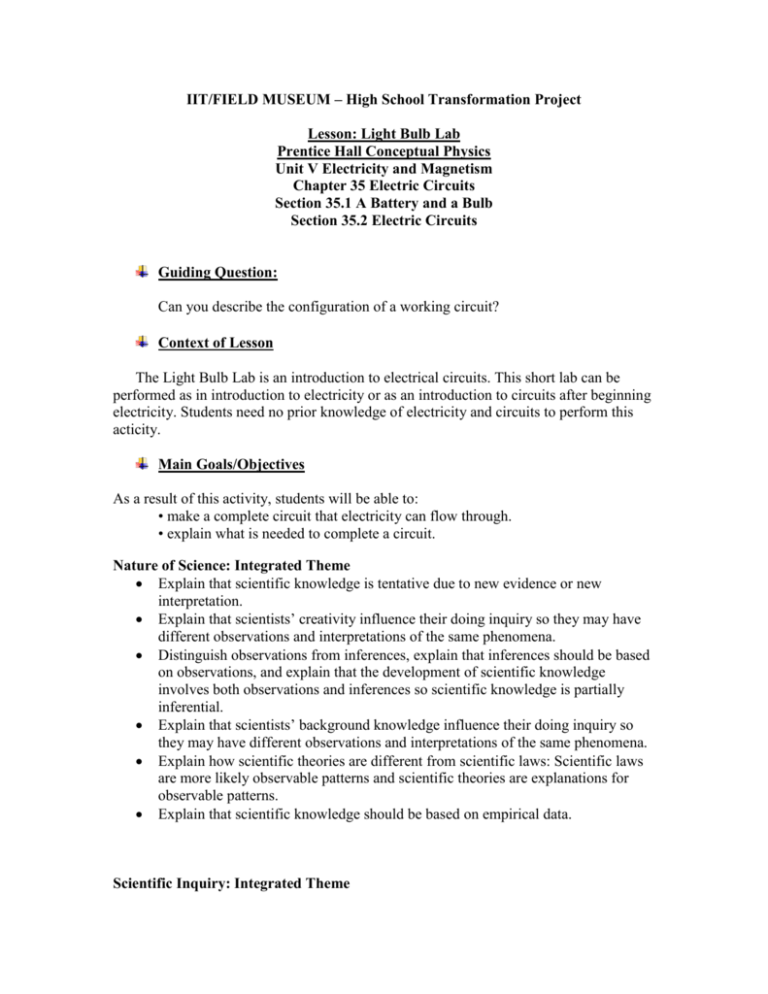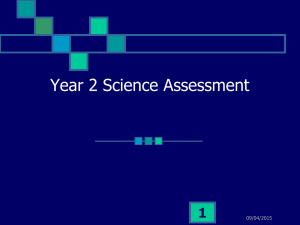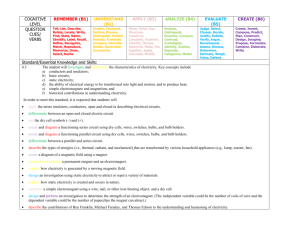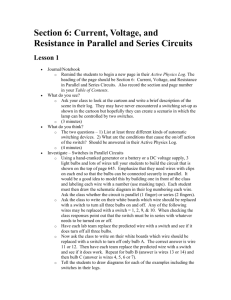Page 1 Lesson: Light Bulb Lab
advertisement

IIT/FIELD MUSEUM – High School Transformation Project Lesson: Light Bulb Lab Prentice Hall Conceptual Physics Unit V Electricity and Magnetism Chapter 35 Electric Circuits Section 35.1 A Battery and a Bulb Section 35.2 Electric Circuits Guiding Question: Can you describe the configuration of a working circuit? Context of Lesson The Light Bulb Lab is an introduction to electrical circuits. This short lab can be performed as in introduction to electricity or as an introduction to circuits after beginning electricity. Students need no prior knowledge of electricity and circuits to perform this acticity. Main Goals/Objectives As a result of this activity, students will be able to: • make a complete circuit that electricity can flow through. • explain what is needed to complete a circuit. Nature of Science: Integrated Theme Explain that scientific knowledge is tentative due to new evidence or new interpretation. Explain that scientists’ creativity influence their doing inquiry so they may have different observations and interpretations of the same phenomena. Distinguish observations from inferences, explain that inferences should be based on observations, and explain that the development of scientific knowledge involves both observations and inferences so scientific knowledge is partially inferential. Explain that scientists’ background knowledge influence their doing inquiry so they may have different observations and interpretations of the same phenomena. Explain how scientific theories are different from scientific laws: Scientific laws are more likely observable patterns and scientific theories are explanations for observable patterns. Explain that scientific knowledge should be based on empirical data. Scientific Inquiry: Integrated Theme Explain that scientific investigations all begin with a question, but do not necessarily test a hypothesis Explain that there is no single scientific method and provide at least two different methods Explain that inquiry procedures are guided by the question asked Explain that all scientists performing the same procedures may not get the same results Explain that inquiry procedures can influence the results Explain that research conclusions must be consistent with the data collected Explain that scientific data are not the same as scientific evidence Explain that explanations are developed from a combination of collected data and what is already known General Alignment to Standards STATE GOAL 11: Understand the processes of scientific inquiry and technological design to investigate questions, conduct experiments, and solve problems A. Know and apply the concepts, principles and processes of scientific inquiry. ILS 11.A.4a Formulate hypothesis referencing prior research and knowledge ILS 11.A.4b Conduct controlled experiments or simulations to test hypotheses ILS 11.A.4c Collect, organize and analyze data accurately and precisely STATE GOAL 12: Understand the fundamental concepts, principles and interconnections of the life, physical and earth/space sciences. C. Know and apply concepts that describe force and motion and the principles that explain them. ILS 12.C.2a Describe and compare types of energy including light, heat, sound, electrical and mechanical. D. Know and apply concepts that describe force and motion and the principles that explain them. ILS 12.D.3a Explain and demonstrate how forces affect motion (e.g., action/reaction, equilibrium conditions, free-falling objects). PSAE Goals: STANDARD 12D – FORCE AND MOTION 12.11.80 Understand that the electrical force is a universal force that exists between any two charged objects. Opposite charges attract, like charges repel. The strength of the force is proportional to the charges, and, like gravity, it is inversely proportional to the square of the distance between the charged bodies. 12.11.81 Understand that between any two charged particles, the electrical force is vastly greater than the gravitational force. Most observable forces such as those exerted by a coiled spring or friction may be traced to electrical forces acting between atoms and molecules. Materials – for each group (2-3 people) • D-cell • 1 wire <1 foot long • small light bulb (ex:1.5V or slightly larger) Lesson This lesson can be completed in one class period. The majority of the class period is spent with the students investigating how to light a lamp (light bulb) using only one cell, and one wire. The last 10-15 min can be used to discuss the student’s findings. Bell Ringer Lab Activity Have the students break into small groups of 2-3 people. Tell students that they will be getting the following equipment: one D-cell, one wire, and one light bulb. Before they experiment, they must come up with at least 4 (5 or 6 if you want to be difficult) distinct ways they can light the bulb. Each group must sketch their 4 distinct ways to light the bulb before they can begin testing them. Have the groups show you the sketches in order to get the equipment. Tell the students that they may not cut or strip the wire in any way. Once all the groups have their bulb, wire, and cell, they will test their ideas. If one or more of their arrangements does not work, they are to keep trying other arrangements until they find 4 different ways to light the bulb. They must hand in their original idea sketches, explain whether they worked or not, and sketch all the other arrangements that did work. They must have a total of 4 arrangements that lit the bulb, before the end of class. As the students work, occasionally check in with the groups to see how they are doing. Try not to give them any answers about how to light the bulb, but make sure the ways that they are finding are actually different. Once a group has 4 ways, you can allow them to “sell” their services to another group that is struggling, as long as you feel that the groups have had enough time to try a number of different arrangements. When all groups have discovered the 4 ways, the class can discuss their findings. Teacher Notes This activity can be done at the very beginning of the unit on electricity. The difference between electrostatics and electricity may be explained, but the ideas of current and voltage are not needed for the activity. This is a discovery for the students. Give the students as little guidance as possible; frustration is good. Discussion (10-15 min) Call on a member of a group to draw a sketch of one of their working ways on the board/overhead. Have them explain what the picture is showing. If need be, standardize how they draw the parts of their set-up (what is the cell, what is the wire, what is the bulb). Have a second group draw a different way. Make sure they are in fact different. The 4 working circuits look as following: Define “circuit”; a complete circle, no openings, for electricity to travel. The electricity (electrons) traveled from the cell ( - end) through the wire/through the bulb, through the bulb/wire, and back to the cell (+ end). The same happens with electricity from an outlet in your home. In your home it leaves the outlet, through the wire, into a lamp, back through the wire and into the outlet. To get to the outlet, it came from a power plant and through wires to your home. After it has returned to the outlet, it travels back through a wire to the power plant. After the class discussion, debrief the students on their knowledge of Scientific Inquiry and the aspects of the Nature of Science. When debriefing the students, refer to your charts posted in the classroom. Probe the students on which aspects of the Nature of Science were applicable in this lesson. Refer to the lists at on the first page of the model lesson. The students should be able to come up with most, if not all, of the items on the list. If a student identifies an item that is not on the list, but has a rationale or justification for including it, then include this item, too. Homework Possible home investigation: Make a list of items at home that run on electricity. Explain the complete loop. Assessment The teacher will walk around the classroom as the students are working in their groups. The students’ understanding of a working circuit will be determined from observing them as they do the activity, their drawings, their responses during class discussion and from their answers to the homework. Modifications/Accommodations This is a hands-on lab, and is well-suited for English language learners, or students whose language skills are poor. Special education students can be paired with a non-special education student. Students with visual impairments should be persuaded to become familiar with the materials. Depending on the light bulbs used, visually impaired students can touch the light bulbs and feel the heat generated. Extensions 1. If this lesson is at beginning of electricity: Since the students have worked with a voltage source (the cell) this can lead to discussing electric potential energy, voltage (electric potential energy per charge), and voltage sources. 2. If this lesson introduces circuits: Continue the investigation of circuits by discussing series and parallel circuits (35.3, 35.4), or use the pictures drawn by the students of their simple circuits to introduce a standard schematic representation of a circuit (35.5).







